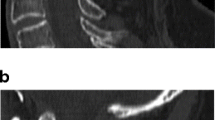Abstract
Objective
To assess what kind of information MR examination in flexed and extended positions provides in Down syndrome subjects with suspected cranio-cervical instability.
Methods
Between 2005 and 2008, 35 subjects with DS were recruited in the study. Ethics committee approval was granted and a signed informed consent was obtained from the parents. All the subjects were affected by hypotonic status and ligament laxity established by clinical evaluation, but were asymptomatic about focal neurological symptoms due to medullar damage caused by cranio-cervical instability. Each patient underwent lateral supine radiographs and MR imaging in the neutral, active flexed and extended positions. For evaluating the atlanto-axial and atlanto-occipital joint stability, multiple measurements were calculated.
Results
A significant reduction of anterior subarachnoid space in flexed position was evident in DS subjects compared to healthy controls in neutral and flexed positions. Both, space available for cord and ligamentous thickness showed significant differences between DS subjects and healthy controls.
In DS subjects with occipito-cervical instability, the anterior subarachnoidal space reduction was significantly reduced in flexed position.
Conclusions
In DS subjects with asymptomatic cranio-cervical instability, anterior subarachnoidal evaluation and ligamentous status could add new information about the risk of spinal cord damage.


Similar content being viewed by others
References
Amato C, Moschini M, Cioni M, Bianco M. Changes in the cranio-cervical junction in Down’s syndrome. Radiol Med. 1990;79:42–7.
McKay SD, Al-Omari A, Tomlinson LA, Dormans JP. Review of cervical spine anomalies in genetic syndromes. Spine. 2012;37:E269–77.
Dedlow ER, Siddiqi S, Fillipps DJ, Kelly MN, Nackashi JA, Tuli SY. Symptomatic atlanto-axial instability in an adolescent with trisomy 21 (Down’s syndrome). Clin Pediatr. 2013;52:633–8.
Hankinson TC, Anderson RCE. Craniovertebral junction abnormalities in Down syndrome. Neurosurgery. 2010;66:A32–8.
American Academy of Pediatrics. Committee on sports medicine and fitness. Atlantoaxial instability in down syndrome: subject review. Pediatrics. 1995;96:151–4.
Pueschel SM. Should children with down syndrome be screened for atlantoaxial instability. Arch Pediatr Adolesc Med. 1998;152:123–5.
Pueschel SM, Herndon JM, Gelch MM, Senft KE, Scola FH, Goldberg MJ. Symptomatic atlantoaxial subluxation in persons with down syndrome. Pediatr Orthop. 1984;4:682–8.
Pizzutillo PD, Herman MJ. Cervical spine issues in down syndrome. J Pediatr Orthop. 2005;25:253–9.
Rojas CA, Bertozzi JC, Martinez CR, Whitlow J. Reassessment of the craniocervical junction: normal values on CT. AJNR Am J Neuroradiol. 2007;28:1819–23.
Menezes AH. Specific entities affecting the craniocervical region: Down’s syndrome. Childs Nerv Syst. 2008;24:1165–8.
Taylor TK, Walter WL. Screening of children with down syndrome for atlantoaxial (C1-2) instability: another contentious health question. Med J Aust. 1996;165:448–50.
Gabriel KR, Manson DE, Carango P. Occipito-atlantal translation in Down’s syndrome. Spine. 1990;15:997–1002.
Harris JH Jr, Carson GC, Wagner LK. Radiologic diagnosis of traumatic occipitovertebral dissociation: 1. Normal occipitovertebral relationships on lateral radiographs of supine subjects. AJR Am J Roentgenol. 1994;162:881–6.
Tredwell SJ, Newman DE, Lockith G. Instability of the upper cervical spine in Down syndrome. J Pediatr Orthop. 1990;10:602–6.
Pueschel SM, Moon AC, Scola FH. Computerized tomography in persons with Down syndrome and atlantoaxial instability. Spine. 1992;17:735–7.
Brockmeyer D. Down syndrome and craniovertebral instability. Topic review and treatment recommendations. Pediatr Neurosurg. 1999;31:71–7.
Smoker WR, Khanna G. Imaging the craniocervical junction. Childs Nerv Syst. 2008;24:1123–45.
Pueschel SM, Scola FH, Pezzullo JC. A longitudinal study of atlanto-dens relationship in asymptomatic individuals with Down syndrome. Pediatrics. 1992;89:1194–8.
Cremers MJ, Bol E, de Roos F, van Gijn J. Risk of sports activities in children with Down’s syndrome and atlanto-axial instability. Lancet. 1993;342:511–4.
Conflict of Interest
None.
Source of Funding
None.
Author information
Authors and Affiliations
Corresponding author
Rights and permissions
About this article
Cite this article
Romano, A., Albertini, G., Guida, D. et al. A Cervical Flexion-Extension MRI Study in Down Syndrome. Indian J Pediatr 82, 349–353 (2015). https://doi.org/10.1007/s12098-014-1549-6
Received:
Accepted:
Published:
Issue Date:
DOI: https://doi.org/10.1007/s12098-014-1549-6




